CARBONDALE, ILLINOIS
GEODESIC DOME, MOTREAL
DYMAXION HOUSE, KANSAS
BLACK MOUNTAIN COLLEGE

CARBONDALE, ILLINOIS
GEODESIC DOME, MOTREAL
DYMAXION HOUSE, KANSAS
BLACK MOUNTAIN COLLEGE
BY JACOB ROBERTS
This essay sets out to explore and criticise the theme of learning in contrast with the methodologies, philosophies and concepts integrated with the Architect ‘R. Buckminster Fuller’.

Fullers approach to architecture is unique and rich with exploration, his bringing of theoretical ideas around learning were fuelled by his philosophies that drove the commitment and success on his projects in a light of which transcended far beyond the conventions of specialization in the profession. Buckminster Fuller was able to explore architecture in the light of a new door opening and we as pioneers of design are peering through. This essay invites you to explore the works of Fuller in the balance of both theory and practice as a singularity for questions to be answered and concepts to be discovered.

Initially, it is fascinating to ask, can learning serve as a significant part of a design processes? The question explores the contradictions between the learning and the learnt; if we are deemed as practicing designers, then we already know what it is we must do to live up to our reputation. On the contrary, if we are learning; then one can only assume we may not already know what to do?
Through this scope of exploration of Fullers philosophies towards learning, we can start to unravel the motivations that led one towards the success of the Geodesic Domes and the Dymaxion House, which will both be referenced in this essay as examples of what we can accomplish when the bold approach of interdisciplinary knowledge is incorporated into architecture.
My research is often inspired by a self-reflection of constantly wanting to expand knowledge by learning through trying new approaches, testing ideas and retreating back to the drawing board when design requires a second thought. Naturally was drawn to questioning Buckminster Fullers’ approach, in light of inquisitive of how we as designers and future Architects can find capable design solutions by embedding learning within the design process of not just architecture, but within the expansion of all occupations it may reach out to.
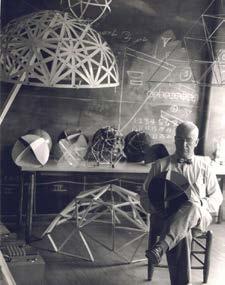

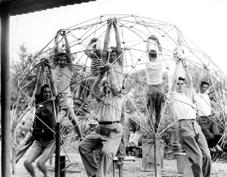
Richard Buckminster Fuller (FIG. 2) was an American Architect from Milton, Massachusetts, USA. In his early years Fuller belonged to a family of strong individualists who were inclined towards activism and public service. Through his younger years he familiarised himself with the name “Bucky” and started to develop an early understanding of nature and the principles of boat maintenance and construction. Fuller went on to entering Harvard university where he was expelled twice due to excessively socialising and missing midterm exams (Buckminster Fuller Institute,1997). After his service in the US Navy between 1917 and 1919 Fuller took on the role of an Architect, although he was not certified to practice architecture his professional practice was intertwined with teaching, an emphasis on project based learning and
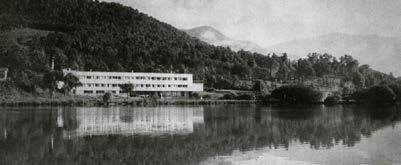
close collaborations with colleagues and students (Spatial Agency, 2011).
Through his collaborations in practice, he also took it upon himself to personally teach as a professor at the Black Mountain College (FIG.5) in North Carolina where he was able to collaborate with Walter Gropius, Josef Albers and John Cage, all who were detrimental to Fullers experimentational ideologies embedded in his approach to learning and practicing. Naturally, Black Mountain College took an alternative approach towards education that to what we may consider as conventional. There was no grade and students worked and lived alongside their colleagues and teachers. There was an approach to equal emphasis to creativity and practical responsibility – an ideal setting for a man such as Buckminster Fuller (Spatial Agency, n.d).
Throughout his work, Fuller incorporated his approaches of learning through experimentation and system thinking where he was
able to develop on his ideologies around a holistic design philosophy, coining the term “Comprehensive Anticipatory Design Science” – (Díaz, 2014).
He was renowned for his interdisciplinary approaches to his projects, ranging across architecture, mathematics, philosophy, design and science, where he was able to develop his theoretical work regarding the structure of particles, later discovering the mathematical formula for the closest packing of spheres (Spatial Agency, n.d). His advancement into his multi-disciplinary and experimental approaches to design concluded with projects such as the Geodesic domes and Dymaxion House (FIG.3), all of which are products of his unique design procesws that separates him beyond many who embark in the discourse of Architecture.
Buckminster Fullers influence on learning ranged across numerous schools over America where he was able to develop his strategies of teaching and endorse students with his philosophy of research led by experimentation in smaller research teams. (Colomina, Galán, Kotsioris, & Meister, 2022). Fullers’ philosophy towards learning expanded into multiple definitions that he coined under the term of ‘Synergetics’ (Buckminster Fuller Institute, 2021). Synergetics was a way in which Fuller spent incorporating a range of ideologies towards learning that specifically conclude through experimentation and cooperation. His concept was inspired by the patten of interconnectedness within the systems that make up the universe and encourages recognition to apply these universal principles to education through his students. His philosophy behind learning extends through experimentation in his work. Fullers’ pursuit in direct engagement was critical to challenging conventional education methods by viewing iterative experimentation alongside a hands-on approach to problem solving as a process that is integral to education (Fuller. R, 1979). Through his previous experience in education and learning Fullers’ views were stated that the classroom was “dulled, overloaded, stuffed and paralyzed” (Hornyak,
2019). Therefore, through his own interpretations and methodologies Fullers goal set out to ‘Free’ students and give responsibility to them for their own creativity.
Buckminster Fullers views around learning as an iterative process was executed through ideas based around learning by doing. His beliefs were the foundation of his iterative and experimental process of learning, which he reinforced is invaluable for solving global challenges that we face today. By using a synergetic approach Fuller asks to work cooperatively, not just with one human interaction to another, but rather looking into the ‘Design Science’ of the universe and cooperating with it by utilising the resources that can offer us with opportunity to expand on our current perceptions. Ultimately providing ourselves with valuable solutions (Fuller. R, 1979).
Fuller viewed design and solution finding a non-linear process, his philosophies are rooted deeply around failure being just as important as success in his experimentations. Development through theory can lead to wrong answers. However, his ideas surrounding this expand more beyond just theoretical approaches, putting these ideas to the test through practical experiments can lead us to solutions and accepting them as part of that process.
Additionally, Fuller expanded his concepts further to create and apply philosophies such as ‘Comprehensive Design Science’ to projects such as the Geodesic domes or the Dymaxion House. Furthermore, Fullers ideas took a more global and interconnected perspective by questioning the way western societies
associate specializations with strict technical and scientific training within professions. Instead, Fuller implements a multi-disciplinary application to his projects, which notably surged a trend of utopian thinking through his term of ‘Spaceship Earth’ eventually becoming part of his legacy (Gano, 2015). Buckminster Fullers ‘Spaceship Earth’ was invented as a holistic and system thinking perspective around understanding global problems from an interconnected perspective. His Philosophy can be used as an introduction to us around his aspects of design, learning and the ideologies behind comprehensive design science and what they offer in terms of opportunities for learning and encompassing a diverse discipline of design, science, engineering and economics (R.Fuller, 1969). This philosophy shifts from the approach around single disciplines in the field of architecture but rather view knowledge as interconnected and holistic, where connectivity is in everything. Therefore, a utopian world which satisfies the needs of 100% of humanity can be achieved if humanity itself works together amongst interdisciplinary action (Buckminster Fuller

Buckminster Fullers designs and methods was an extension of his philosophies built around Learning as one of the foundational parts to his design process. It was seen as a strong component that he applied as an instrument for refinement throughout projects. His philosophy of ‘comprehensive anticipatory design science’ was key to his approach and carried out through to completion on his projects through learning strongly based off experimentation and experience. Secondly, Fuller insisted on taking a holistic approach to problem-solving. Fullers’ designs were able to take form throughout constant adaptation and transformations using systematic learning and feedback in his attempts through theoretical solutions applied to practice (Geometrymatters, 2023). Fullers work is based strongly from prototyping his ideas and continually improving and redefining them through cycles of experimentation, observation and redesign. This was Fullers fundamental basis for his solutions and approach to problem solving learning by testing ideas through a series of simulations and arriving at conclusions from iterative adaptation and perfecting concepts.



The methodologies incorporated in Fullers process of design through iterative problem solving and learning integration directed him to his invention and the subsequent success of the geodesic domes (Fig.7). The success of the Geodesic Domes comes from Fullers applied philosophies that transcends a singular field of study. As he was one with experimentation this did not become subjected to the field of architecture and engineering but beyond the broader reaches of occupations. Buckminster Fuller had a deep commitment to improving human well-being through design by utilizing his methods of approach via self-directed experimentation in conjunction with ‘seeing oneself as an experiment’ (Ettinger, 2023). The concepts that surrounded Fuller leading up to the invention of his Geodesic domes is driven from his understanding and learning of absolute universal principles and systematically connecting this to direct human problems (Ettinger, 2023).
Fuller mirrored a lot about his self-reflection as seeing the universe as one big experiment meant he was able to view his self in the same way categorising himself as “every-man” (Gorman, p.12, 2005). Adopting this, his capabilities allowed him to proceed with studying the tools and information offered by the universe, specifically found in nature. Learning from nature was the motivation, taking a vital role in the development of the geodesic domes. Inspiration and motivation initially stemmed from his ideologies based around “More for less” – utilising a structure that was capable of withstanding strong natural forces while minimising the physical build up. It was fullers’ perception on learning from Nature and his belief that the universe in its connected ways that hold the solutions to problems and creativity.
Buckminster Fuller often took on global challenges through diverse influences from multidisciplinary learning actions in which he applied to the field of architecture. Firstly, in Fullers applied theories the design and configuration of the geodesic dome. Coincidently the theory of Fullers design stemmed from multidisciplinary sources such as mathematic and geometry, specifically based on the division of spheres into triangles. It was his experimentation alongside this where he was able to try and conclude from experimentation at Black Mountain College where students would work in small teams under Fuller to formulate a construct of geometric composition with such structural integrity in the form of a dome (Buckminster Fuller Institute, 2021). In Fullers combination with experimentation went hand in hand with his interdisciplinary action around architecture, engineering and Natural Science as some may argue that they are a citation of the Natural Biology of different lifeforms around the structural integrity involved in the build-up of certain aspects such as ‘the flies’ eyes’ (As seen in fig. 9). However, Fuller rejects this and proposes that the geodesic domes are true inventions rather than “merely revelations of phenomena present in nature” (Gorman, pg. 122, 2005).




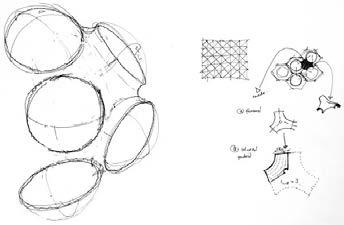
Learning from the universe gave emphasis to Fullers theory that knowledge must expand beyond the grounds of one particular field of study but perhaps led into the discipline of engineering and industrial design. This was primarily demonstrated in the design and prototype of the Dymaxion House (FIG. 8) a familiar comparison of the mathematic, engineering and science intertwined with architecture.
His intuitive understanding of engineering was deeply embedded into the solution behind facing global problems and learning a discipline from a multitude of applications. The house used tension suspension from the central column, and the home was a design for its basic heating or cooling needs to be acquired from natural means and sources such as the form and geometry of the house (Buckminster Fuller Institute, 2021). Its original purpose was to provide a mobile home capable of breaking the conventional norms of a situated permanent occupied land while utilising the natural environment for its necessary facilities to efficiently operate and serve as an adaptation of technology. Fullers example of learning in a multidisciplinary way are shown as an example of how we can use a range of knowledge in the field of architecture to approach global issues such as the economical housing crisis or efficiency in our use of sustainable materials as demonstrated in the ‘Dymaxion House’. His efforts pushed Fuller to creating a new industry for mass-production in the dymaxion house. However, Fullers reputation as a perfectionist was to use his prototypes as a learning tool – origination from his theories and practice around learning through experimentation and therefore with his reputation his designs never left the prototype stage due to his continuous learning strategies of experimenting with each improvement made.
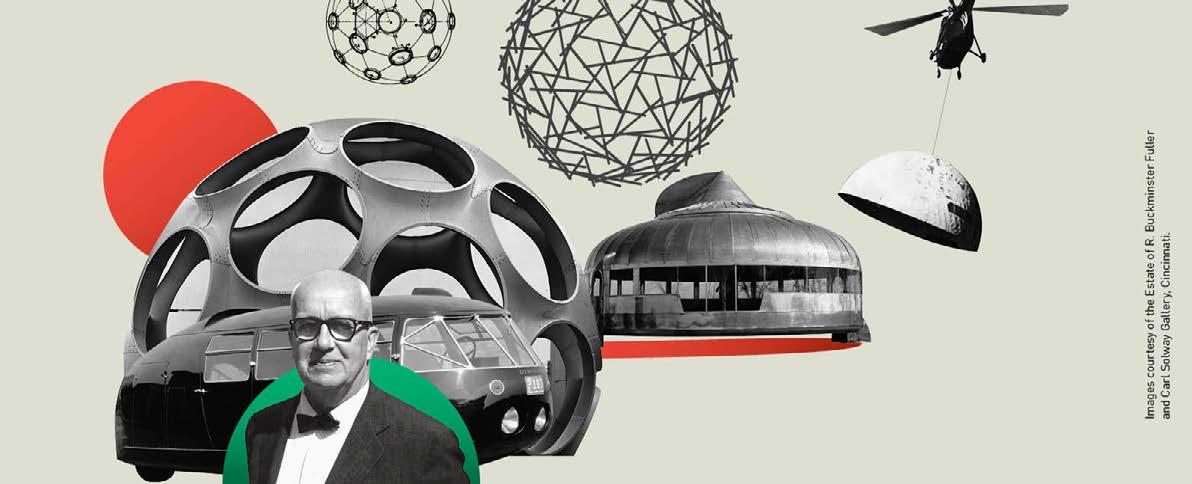
“OBSERVATION OF MY LIFE TO DATE SHOWS THAT THE LARGER THE NUMBER FOR WHOM I WORK, THE MORE POSITIVLY EFFECTIVE BECOME. THUS, IT IS OBVIOUS THAT IF I WORK ALWAYS AND ONLY FOR ALL HUMANITY, WILL BE OPTIMALLY EFFECTIVE.”
- R. BUCKMINSTER FULLER
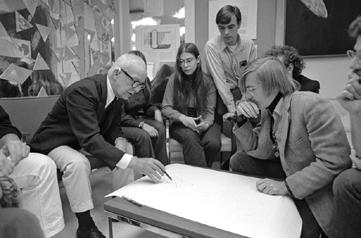

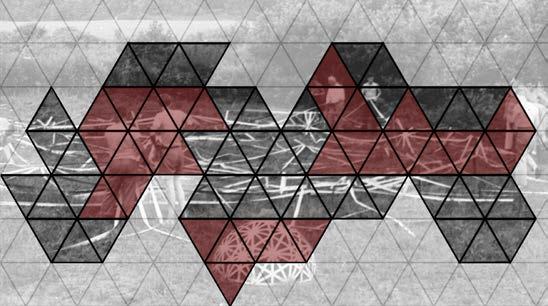
Fuller through his time was able to have many different applications on learning that throughout many architectural practice’s modern day and past has had various impacts. His ideologies and motivations around his philosophy of “doing more with less” is the meaning of “ephemeralization” – coined by Fuller as a way of expressing a concept of doing more with fewer resources. Learning how structure works and applying theory to practice was his methodologies used to maintain a resourceful strategy of how Architects design buildings (University of Missouri, n.d). Fullers’ ideologies around this are a pathway for Architects to approach design for maximum functionality and align with sustainability goals and resource efficiency.
Secondly, Fuller had an emphasis on synergetics – an application he was able to apply to his design process through teaching and learning, questioning the methods of how Architects in standard architectural practices may approach design. Fuller invited Architects to take a perspective of designing buildings by considering them as integrated systems of experimentation and knowledge outside specialisations for more innovative responses to their environments. His concept behind synergetics was to provide a method for thinking and problem solving by identifying and learning from the nature and the universe.
In the designs of the geodesic domes and the Dymaxion house, Fuller exemplifies his contributions to the field of practice in architecture. Utilising an interdisciplinary approach was a key motive for the success of such projects. Buckminster Fullers interdisciplinary action was a way of asking Architects to look beyond a singular field and discipline in practice but in fact taking reference from natural science, engineering and applied geometry as well as exploiting the importance of technology to experiment with existing forms known and seen to work in the theoretical field.
In leading on from theory, Fuller believed that experimentation with knowledge with a multidisciplinary advancement into architecture would apply real conclusions towards lightweight yet strong compositions of structure that can being found in nature. This links on to the

term of “spaceship Earth” devised by Fuller as a strategy in which mankind can use teamwork to fully utilise the given of limited resources Earth has to offer. By adopting this strategy in architecture practices Fullers sees ample opportunity for us to learning from nature, earth and ourselves to find solutions to problems as a means of facing global issues and sustainability challenges. (Fuller, 1963).
Fullers’ intentions are to set out a pathway for future Architects to apply themselves to practicing architecture through methods of learning from a multidisciplinary approach instead of a singular knowledge perspective. In doing this learning can being to become a part of the design process as new discoveries are made to inform the designs from looking at it from different occupations. When we use interdisciplinary approaches to architecture, we can begin to broaden our knowledge on facing global problems that practices are faced with today. By using learning in the design process while practicing architecture Fuller invites designers to learn from what we have in our current archive of knowledge to find solutions. Learning from nature itself and utilising its given facts we can apply his synergetic philosophies to modern day practice by applying his theories to the way we design structure in different forms of geometry and putting them to the test through controlled experimentation and gaining conclusion from both success and failure (Environment and Ecologies, n.d).
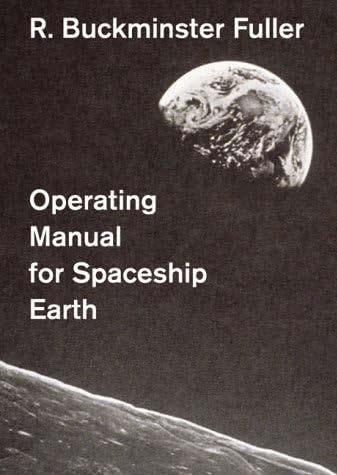
As all theorists, they must be open to the critiques and challenges that solidify their positioning. Fullers’ proposal is that one’s design process should incorporate learning through a comprehensive application (Buckminster Fuller Institute, 2022). This questions how education is seen as from Fullers Point of view. Through his experience Buckminster Fuller states that the current learning process is ‘suppressing’ the creativity and curiosity that we require as mankind to face designing for future global issues. Fuller is suggesting that in overcoming this then designers should become experiential learners as a methodology for problemsolving.
As a hands-on philosopher that Fuller is, then physical engagement to challenges would be no revelation to his methods of grasping deeper understanding and retention on projects, ultimately aiming to encourage learners to take responsibility for their own education and a way of fostering a critical thinking approach to the educational system (Hornyak, 2019). However, the significant challenges that others may argue against Fullers outlook on traditional ways of education are that his emphasis of resourcefulness and sustainability are overlooked, experience may cost in resources such as materials and time (Yun-Chu, 2014). Many educational institutes may lack in this flexibility, therefore does Fuller take this into consideration when utilising a comprehensive learning strategy when applying this to education as well as the architectural design process?

Fullers’ concepts and methodologies could be questioned in the light of being overly idealistic, some may argue that his utopian vision of making the world work for 100% of humanity may not account for the complexities and inequalities that are inherent in global societies. Despite Fullers ambitious approaches towards a utopian world, his overemphasis on technology may often argue that he overlooks the sociocultural aspects on education. While utilising learning as a design process addressing the humanistic and ethical dimensions is just as crucial to the process of technological advancements (Sterry, 2016).
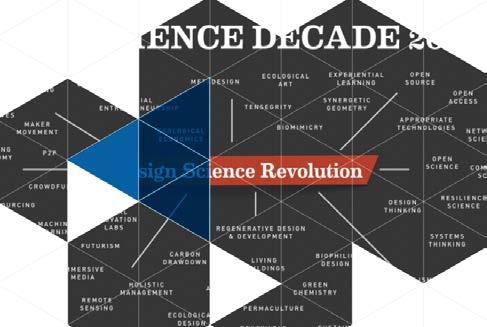
To conclude, Buckminster Fuller uses his ideologies towards challenging the conventional approaches to education and design. He emphasises the integration of learning into the creative design process. Fullers’ commitment to improving the quality of human life is demonstrated in reflection to the projects studied in this essay such as the Geodesic Domes and the Dymaxion House, which illustrate the potentials behind a multi-disciplinary application to problem solving and design. By bridging design and philosophy to nature, Fuller highlights the importance of adopting a holistic perspective and encourages designer to explore projects from multiple viewpoints rather than being specific in a singular specialization. His concepts of ‘Spaceship Earth’ surround the belief that the universe holds the solutions to humanities global challenges calling for humanity to act in harmony with nature.
Furthermore, Buckminster Fuller’s concept of ‘Synergetics’ invites Architects and designers to embrace failure as part of the continuous process of design. His introduction of accepting learning as equal importance redefines the role of Architects and designers as pioneers of sustainability and innovation. In addressing todays rising complex global challenges, this mindset is particularly relevant to the modern-day approach. On the contrary, while Buckminster Fullers methods are visionary and ambitious, they can not go uncritiqued. Fuller often overlook the sustainability and resourcefulness when applying his methods. In his works Fuller was not one to engage in environmental action, his directed resources were not aimed towards it and avoids taking a critical view of the industry and its weaknesses, despite his emphasis on sustainable methodologies (YunChu, 2014). This paradox serves as a reminder that the designer and learner must be willing to balance their mindset with environmental responsibility.
Ultimately, the ideologies of Fuller bring emphasis on the integration of Theory, learning and practice, that remains as a critical lesson for current practicing Architects and designers. When reflecting on my personal experience, contemporary practices often separate learning from performance, but Fuller implies to us that design itself is an experimental process that in order to utilise to its full potential must transcend singular disciplinary boundaries. believe that incorporating learning into our design process we can successfully create spaces that are purposeful as opposed to arbitrary. And focus more on meeting the needs of humanity in essence of fostering innovation. Fullers vision provides the tools for navigating the challenges we face in the modern world,
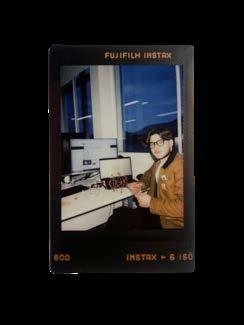


Awan, N., Schneider, T., & Till, J. (2011). Spatial agency : Other ways of doing architecture. London: Routledge.
Buckminster Fuller Institute (2021) R. Buckminster Fuller, 1895 – 1983: Early Life, Retrieved from; https://www.bfi.org/aboutfuller/biography/
Buckminster fuller institute. (n.d). Retrieved from https://www. bfi.org/
Colomina, B., Galán, I. G., Kotsioris, E., & Meister, A. (2022). Radical pedagogies MIT Press. Retrieved from https:// books.google.co.uk/books/about/Radical_Pedagogies. html?id=4kWBzgEACAAJ&redir_esc=y
Díaz, E. (2014). The experimenters: Chance and design at black mountain college. Chicago, IL: University of Chicago Press. Retrieved from https://press.uchicago.edu/ucp/books/ book/chicago/E/bo18291671.html
Environment and Ecology. (n.d). Buckminster fuller. Retrieved from https://environment-ecology.com/biographies/364buckminster-fuller.html?utm_source=chatgpt.com
Ettinger, J. (2023, -09-14T15:15:00+00:00). Inside and outside of the geodesic dome: 5 buckminster fuller life lessons. Retrieved from https://the-ethos.co/buckminster-fuller-life-lessons/
Fuller, R. B. (1979). R. buckminster fuller on education University of Massachusetts Press. Retrieved from https://books.google. co.uk/books/about/R_Buckminster_Fuller_on_Education. html?id=gupKAAAAMAAJ&redir_esc=y
Gano, G. (2015). Starting with universe: Buckminster fuller’s design science now. Futures, 70, 56–64. doi:10.1016/j. futures.2014.12.011
FIGURE 1 IMAGE OF PRAXIS WORLD MAP – ROBERTS. J
FIGURE 2 BUCKMINSTER FULLER WITH PROTOTYPE DOMES, RETRIEVED FROM: https://www. wunc.org/show/the-state-of-things/2015-02-19/the-dynamic-r-buckminster-fuller
Fuller, R. B. (1969). Operating manual for spaceship earth Southern Illinois University Press.
Fuller, R. B., Snyder, J. (2010). Education Automation: Comprehensive Learning for Emergent Humanity. Germany: Lars Muller Publishers.
Gorman, M. J., & Fuller, R. B. (2006). Buckminster fuller: Designing for mobility Skira.
Hornyak, T. (2019, -09-03T07:48:44+00:00). Kinfolk: The education of buckminster fuller. Retrieved from https:// timhornyak.com/the-education-of-buckminster-fuller/
Hsiao-Yun Chu. (2014). R. buckminster fuller’s model of nature: Its role in his design process and the presentation and reception of his work. Retrieved from file:///C:/Users/jaker/Downloads/Final_Thesis_April%202015. pdf
New views on R. buckminster fuller (2009). Retrieved from https://www.academia.edu/8081421/New_Views_on_R_ Buckminster_Fuller
Roibu, T. (2023, -07-11T10:16:43+00:00). Buckminster fuller’s visionary, big ideas. Retrieved from https://geometrymatters. com/buckminster-fullers-visionary-big-ideas/
Sterry, D. H. (2016). Jonathon keats on buckminster fuller, being a critic, a writer, and how to get unusual books published. Retrieved from https://www.huffpost.com/entry/jonathonkeats-on-buckminster-fuller-being-a-critic_b_580e782ae4b0f 8715789ff5c
Spatial Agency (2010) Buckminster Fuller, Retrieved from; https://www.spatialagency.net/database/buckminster.fuller
University of Missouri. (n.d). Buckminster fuller and systems theory. Retrieved from https://umsl.edu/~sauterv/analysis/ Fall2013Papers/Purcell/bucky.html#Table_of_Contents
FIGURE 3 DYMAXION HOUSE DIAGRAM, RETRIEVED FROM: https://www.amazon.co.uk/ maisons-Fuller-Dymaxion-Buckminster-machines/dp/2884741445
FIGURE 4 STUDENTS TESTING GEODESIC DOMES AT B.M.C, RETRIEVED FROM: https://complexcapsule.wordpress.com/2016/09/20/buck-minster-fullers-geodesic-dome-at-blackmountain-college-1949/
FIGURE 5 BLACK MOUNTAIN COLLEGE, RETRIEVED FROM: https://www.minniemuse.com/ articles/musings/black-mountain-college
FIGURE 6 BUCKMINSTER FULLER ‘TIMES’ MAGAZINE, RETRIEVED FROM: https://content. time.com/time/covers/0,16641,19640110,00.html
FIGURE 7 MONTREAL GEODESIC DOME, RETRIEVED FROM: https://www.mathnasium. com/math-centers/westfordchelmsford/news/geodesic-domes
FIGURE 8 DYMAXION HOUSE, RETRIEVED FROM: https://www.bbc.com/culture/article/20140613-spaceship-earth-a-game-of-domes
FIGURE 9 FLYS EYE STRUCTURE, RETRIEVED FROM: https://uk.pinterest.com/ pin/472315079645928474/
FIGURE 10. GEODESIC DOMES THEORETICAL SKETCHES, RETRIEVED FROM: http://proboscis.org.uk/4103/of-fly-eye-domes-and-public-health-data-sets/
FIGURE 11. FULLER MONTAGE, RETRIEVED FROM: https://www.marinabaysands.com/museum/exhibitions/radical-curiosity.html
FIGURE 12. FULLER IN PRACTICE, RETRIEVED FROM: https://will.illinois.edu/21stshow/story/ author-interview-alec-nevala-lee-inventor-of-the-future
FIGURE 13. FULLER EXPLAINING THE DOME STRUCTURE IN PRACTICE: https://the-ethos.co/ buckminster-fuller-life-lessons/
FIGURE 14. FULLER TEACHING HOW TO BUILD THE GEODESIC DOME IN UNIVERSITY – BY ROBERTS. J
FIGURE 15. OPERATING MANUAL FOR SPACESHIP EARTH, RETRIEVED FROM: https://www. amazon.co.za/Operating-Manual-Spaceship-Buckminster-Fuller/dp/3907078233
FIGURE 16. SCIENCE DECADE CONNECTIVITY, RETRIEVED FROM: https://www.bfi.org/programs/bfi-design-lab/design-science-advisory-services/
FIGURE 17. BUILDING THE GEODESIC DOMES MYSELF – ROBERTS, J
FIGURE 18. FINISHED GEODESIC DOME – ROBERTS, J